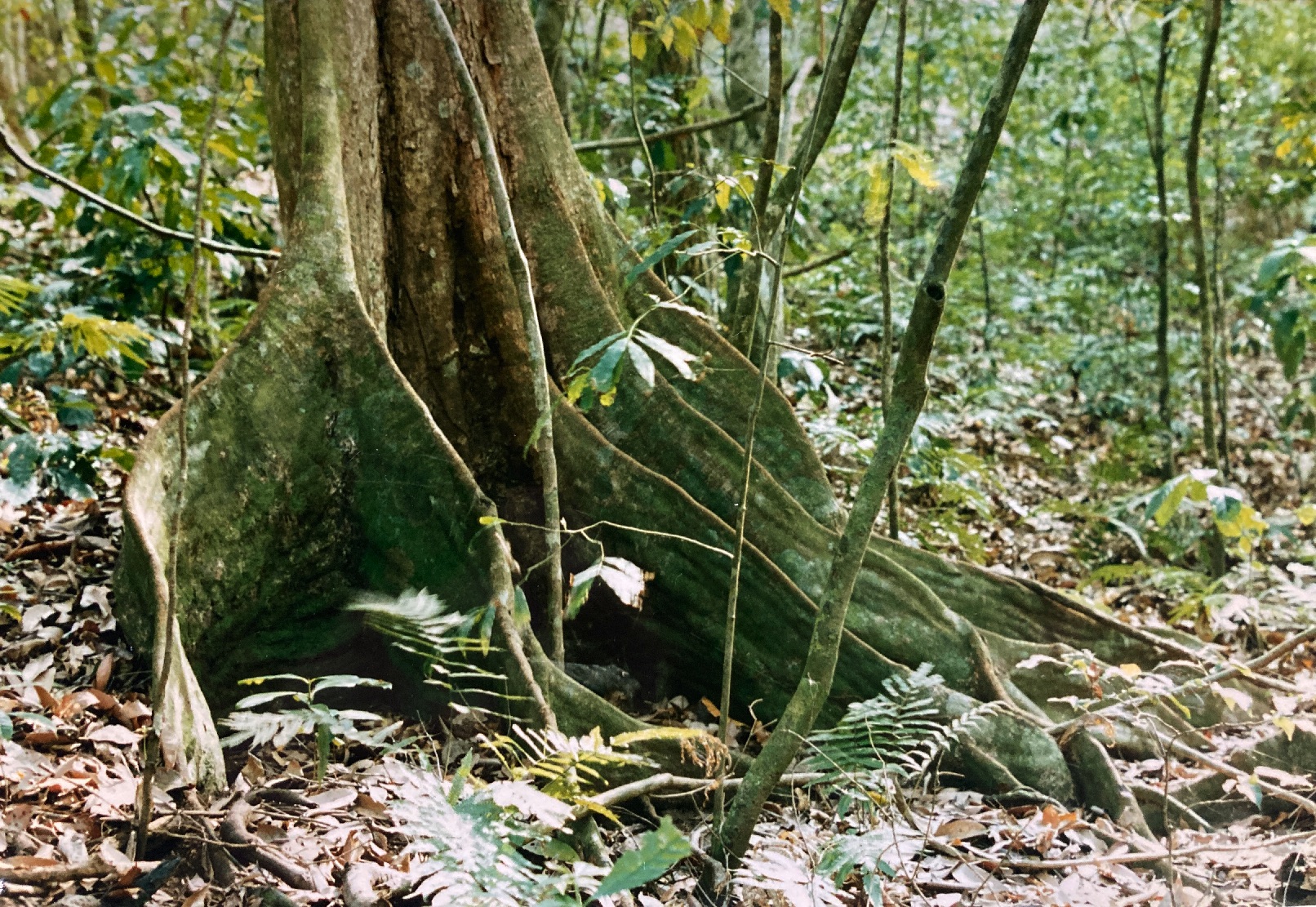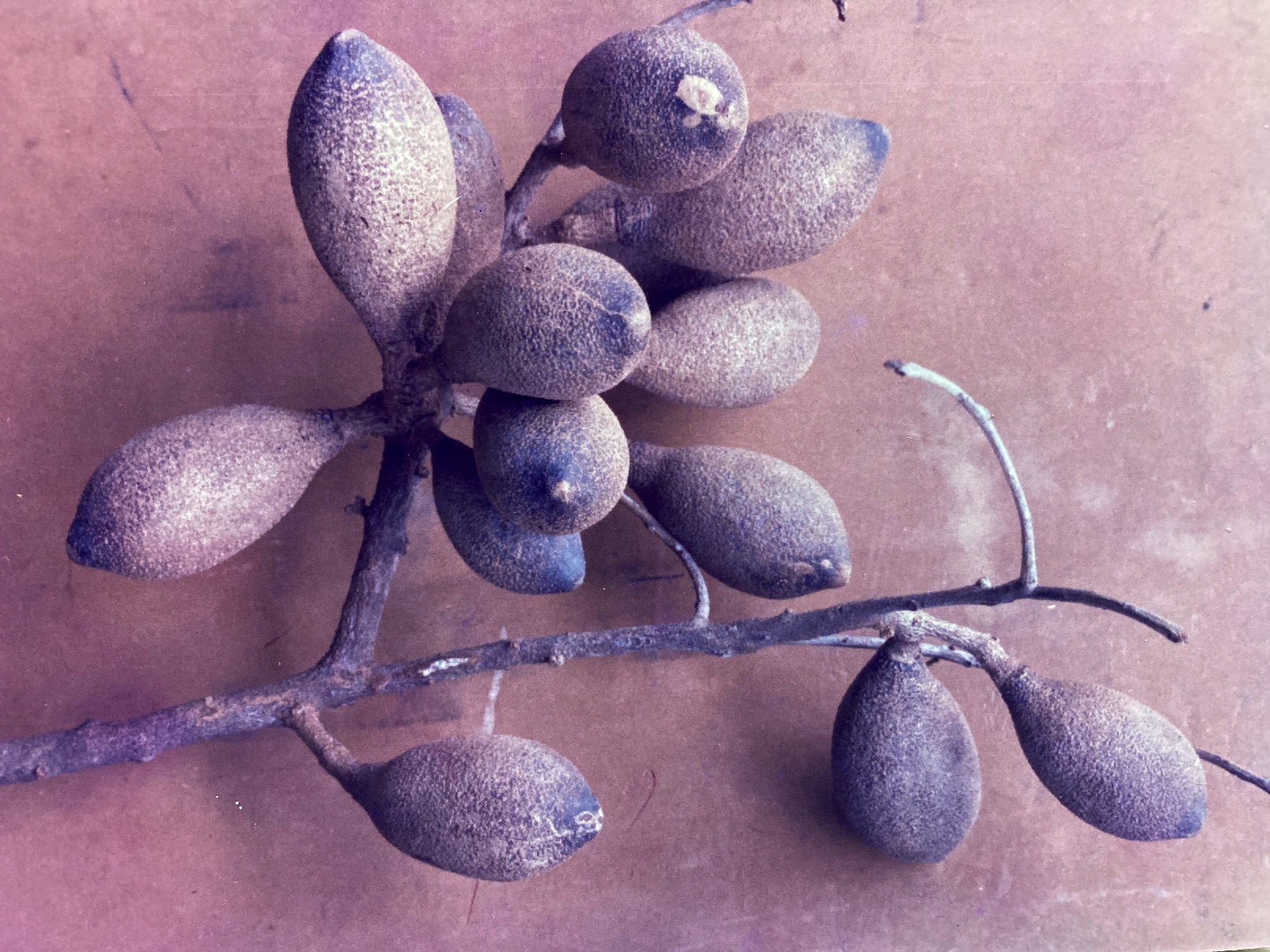Pouteria amygdalicarpa (Pittier) T. D. Penn.
Sapotaceae
SAPOTILLO
Occasional evergreen canopy tree (25-35 m) found thinly distributed throughout the primary forest. Though usually encountered growing as isolated individuals, at least one small stand of these trees is known. Perhaps the first feature to catch the eye, and one of the most distinguishing for this species, are the thin, extended, and wavy buttresses that surround it’s base. Also of interest are the heavy bunches of club-shaped, woody fruits that often burden the crown.
Description: P. amygdalicarpa may become a very large tree with trunk diameters frequently exceeding 60 cm. Boles are straight, mostly cylindrical, and clad in dark brown, smooth bark that is textured by fine, vertical cracks. Extended, thin, and undulating buttress roots meander for several meters across the forest floor before submerging beneath it. So striking and extraordinary are these structures that they serve well for field identification. (They are also among the most aesthetic features to be seen on any tropical forest tree.) Branching occurs along the upper sixth of the bole and the crown they form is rounded, of a single leaf layer, and thick. Leaves are simple, alternate, and elliptically shaped (though their widest point is shifted somewhat distally from center). The smooth, entire blades vary in size but average 19 cm long by 5.5 cm wide and they end in well-developed and conspicuous drip tips. Arranged in two tiers along either side of the grayish or tan twig, the leaves are fastened to it by long, dark brown – and sometimes curved – petioles (2 cm). New foliage (about 10% of the pre-existing cover) is generated annually in December and January.
Flowers grow in very dense clusters from short (1-2 cm) stalks located in old leaf axils (appearing behind the current foliage where the twigs are bare). Each tiny, 3 mm blossom is supported by a 7 mm pedestal that terminates in a yellow-brown, five-part calyx. A minute, five-lobed, pale-green corolla is found within the calyx and ten stamens are fused to its inner surface. Perched atop the reddish ovary, a short pistil occupies the flower’s center. These blossoms emit a mild but sweetly aromatic odor. P. amygdalicarpa trees are not fertile on an annual basis, and in the five years during which observations of this species were made (1989-1993), flowers were observed only in 1989 and 1990. Nor were these universal events, with only about half of known trees participating. When blossoming does occur, the event continues for about three weeks, beginning in late February and lasting through early March.
Visible by June, the immature fruits grow very slowly, requiring about 16 months to reach their final size of 5 cm by 3.5 cm. Plump and rounded, the fruits terminate in stubby points and resemble fat clubs or even tonsils. When ripe, the rough, sandpapery, outer surface turns a rich russet color. Inside, the thick, woody husk protects a tenuous layer of sweet, milky tissue and a single, large, hard-coated seed (3 cm by 2 cm). Dark brown, glossy, and ovoid, this seed bares the typical, buff, Sapotaceae scar across its entire length. The interval between flowering and harvest is so long that a second crop may already be developing even before fruits from the previous year have ripened. Harvests are fairly large (though not annual) and they last from late May through early July. The seeds germinate rapidly after coming into contact with the wet soil. By late June, the ground underneath P. amygdalicarpa trees may be dotted with tall (20 cm), red-stemmed seedlings bearing two or three leaves each.
Similar Species: The Sapotaceae family is a closely knit group and leaf characteristics alone are not usually sufficient to allow for the easy differentiation of its members. The presence of club-shaped fruits in the canopy provides an adequate means to identify P. amygdalicarpa, and these persist all year long when the tree is fertile. Lacking fruits, the thin, long and relatively low buttresses (with maximum heights of less than one meter) often an important distinguishing characteristic. Only one other Manuel Antonio National Park (MANP) species possesses similar – perhaps even more remarkable – buttresses: Sarcaulus sp. nov. However, those of this tree – while thin and extended – are ruler-straight. (Only their upper surface, continuously varying in height, traces out a curving contour.)
Natural History: P. amygdalicarpa flowers are pollinated by insects. Its fruits are eaten by arboreal mammals, particularly White-faced Monkeys. These later animals bite open the fruits and chew off the membranous, milky tissue before dropping the seed – usually intact – to the forest floor, some thirty meters below.
Uses: P. amygdalicarpa fruits contain a thin layer of milky pulp that is edible. Sweet and pleasant tasting, this gooey tissue is deeply buried beneath the thick husk.
Distribution: In MANP, P. amygdalicarpa is found in primary forests like those of Punta Catedral and Puerto Escondido. In Costa Rica, it has also been observed in the forests of the northern Osa Peninsula.



